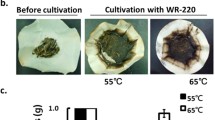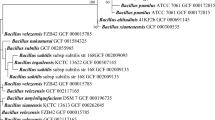Abstract
Anaerobic thermophilic archaea of the genera Thermogladius and Desulfurococcus capable of α- and β-keratin decomposition were isolated from hot springs of Kamchatka and Kunashir Island. For two of them (strains 2355k and 3008g), the presence of high-molecular mass, cell-bound endopeptidases active against nonhydrolyzed and partially hydrolyzed proteins at high values of temperature and pH was shown. Capacity for β-keratin decomposition was also found in collection strains (type strains of Desulfurococcus amylolyticus subsp. amylolyticus, D. mucosus subsp. mobilis, and D. fermentans).
Similar content being viewed by others
References
Alibardi, L., Adaptation to the land: the skin of reptiles in comparison to that of amphibians and endotherm amniotes, J. Exp. Zool. B: Mol. Dev. Evol., 2003, vol. 298, pp. 12–41.
Maderson, P.F., Rabinowitz, T., Tandler, B., and Alibardi, L., Ultrastructural contributions to an under-standing of the cellular mechanisms involved in lizard skin shedding with comments on the functions and evolution of a unique lepidosaurian phenomenon, J. Morphol., 1998, vol. 236, pp. 1–24.
Dalla Valle, L., Nardi, A., Belvedere, P., Toni, M., and Alibardi, L., Betakeratins of differentiating epidermis of snake show that they are glycine-proline-rich proteins with an avian-like gene organization, Dev. Dyn., 2007, vol. 236, pp. 1939–1953.
Brandelli, A., Daroit, D.J., and Riffel, A., Biochemical features of microbial keratinases and their production and applications, Appl. Microbiol. Biotechnol., 2010, vol. 85, pp. 1735–1750.
Onifade, A.A., Al-Sane, N.A., Al-Musallam, A.A., and Al-Zarban, S., Potentials for biotechnological applications of keratin-degrading microorganisms and their enzymes for nutritional improvement of feathers and other keratins as livestock feed resources, Bioresour. Technol., 1998, vol. 66, pp. 1–11.
Brandelli, A., Bacterial keratinases: useful enzymes for bioprocessing agroindustrial wastes and beyond, Food Bioprocess. Technol., 2008, vol. 1, pp. 105–116.
Ghosh, A., Chakrabarti, K., and Chattopadhyay, D., Cloning of feather-degrading minor extracellular protease from Bacillus cereus DCUW: dissection of the structural domains, Microbiology (UK), 2009, vol. 155, pp. 2049–2057.
Nam, G.W., Lee, D.W., Lee, H.S., Lee, N.J., Kim, B.C., Choe, E.A., Hwang, J.K., Suhartono, M.T., and Pyun, Y.R., Native-feather degradation by Fervidobacterium islandicum AW-1, a newly isolated keratinase producing thermophilic anaerobe, Arch. Microbiol., 2002, vol. 178, pp. 538–547.
Moallaei, H., Zaini, F., Larcher, G., Beucher, B., and Bouchara, J.P., Partial purification and characterization of a 37 kDa extracellular proteinase from Trichophyton vanbreuseghemii, Mycopathologia, 2006, vol. 161, pp. 369–375.
Nouripour-Sisakht, S., Rezaei-Matehkolaei, A., Abastabar, M., Najafzadeh, M.J., Ahmadi, B., and Hosseinpour, L., Microsporum fulvum, an ignored pathogenic dermatophyte: a new clinical isolation from Iran, Mycopathologia, 2013, vol. 176, pp. 157–160.
Cao, L., Tan, H., Liu, Y., Xue, X., and Zhou, S., Characterization of a new keratinolytic Trichoderma atroviride strain F6 that completely degrades native chicken feather, Lett. Appl. Microbiol., 2008, vol. 46, pp. 389–394.
Tsiroulnikov, K., Rezai, H., Bonch-Osmolovskaya, E., Nedkov, P., Gousterova, A., Cueff, V., Godfroy, A., Barbier, G., Mutro, F., Chobert, J.-M., Clayette, P., Dormont, D., Grosclaude, J., and Haertle, T., Hydrolysis of the amyloid prion protein and nonpathogenic meat and bone meal by anaerobic thermophilic prokaryotes and streptomyces subspecies, J. Agric. Food Chem., 2004, vol. 52, pp. 6353–6360.
Kublanov, I.V., Bidjieva, S.Kh., Mardanov, A.V., and Bonch-Osmolovskaya, E.A., Desulfurococcus kamchatkensis sp. nov., a novel hyperthermophilic protein-degrading archaeon isolated from a Kamchatka hot spring, Int. J. Syst. Evol. Microbiol., 2009, vol. 59, pp. 1743–1747.
Kublanov, I.V., Perevalova, A.A., Slobodkina, G.B., Lebedinsky, A.V., Bidzhieva, S.Kh., Kolganova, T.V., Rumsh, L.D., Haertle, T., and Bonch-Osmolovskaya, E.A., Biodiversity of thermophilic prokaryotes with hydrolytic activities in hot springs of Uzon Caldera, Kamchatka, Appl. Environ. Microbiol., 2009, vol. 75, pp. 286–291.
Widdel, F. and Bak, F., Gram-negative mesophilic sulfate-reducing bacteria, in The Prokaryotes, 2nd ed., Balows, A., Truper, H.G., Dworkin, M., Harder, W., and Schleifer, K.H., Eds., New York: Springer, 1992, pp. 3352–3378.
Perevalova, A.A., Svetlichny, V.A., Kublanov, I.V., Chernyh, N.A., Kostrikina, N.A., Tourova, T.P., Kuznetsov, B.B., and Bonch-Osmolovskaya, E.A., Desulfurococcus fermentans sp. nov., a novel hyperthermophilic archaeon from a Kamchatka hot spring, and emended description of the genus Desulfurococcus, Int. J. Syst. Evol. Microbiol., 2005, vol. 55, pp. 995–999.
Park, D., Genomic DNA isolation from different biological materials, in Protocols for Nucleic Acid Analysis by Nonradioactive Probes, 2nd ed., Hilario, E. and Mackay, J., Eds., Totowa: Humana, 2007, vol. 353, pp. 3–13.
Sokolova, T.G., Kostrikina, N.A., Chernyh, N.A., Tourova, T.P., Kolganova, T.V., and Bonch-Osmolovskaya, E.A., Carboxydocella thermautotrophica gen. nov., sp. nov., a novel anaerobic, CO-utilizing thermophile from a Kamchatkan hot spring, Int. J. Syst. Evol. Microbiol., 2002, vol. 59, pp. 1961–1967.
Altschul, S.F., Madden, T.L., Schaffer, A.A., Zhang, J., Zhang, Z., Miller, W., and Lipman, D.J., Gapped BLAST and PSI-BLAST: a new generation of protein database search programs, Nucleic Acids Res., 1997, vol. 25, pp. 3389–3402.
Bidzhieva, S.Kh., Perevalova, A.A., Podosokorskaya, O.A., Lebedinsky, A.V., and Bonch-Osmolovskaya, E.A., Metabolic diversity of Desulfurococcus spp. and reclassification of Desulfurococcus kamchatkensis as Desulfurococcus amylolyticus subsp. kamchatkens, 12th Thermophiles, Regensburg, 2013, p. 82.
Kublanov, I.V., New anaerobic thermophilic prokaryotes and their hydrolytic enzymes, Cand. Sci. (Biol.) Dissertation, Moscow: Institute of Microbiology. 2007.
Mardanov, A.V., Kochetkova, T.V., Beletsky, A.V., Bonch-Osmolovskaya, E.A., Ravin, N.V., and Skryabin, K.G., Complete genome sequence of the hyperthermophilic cellulolytic crenarchaeon “Thermogladius cellulolyticus” 1633, J. Bacteriol., 2012, vol. 194, no. 16, pp. 4446–4447.
Kashefi, K., Extremophiles. Microbiology and biotechnology, in Hyperthermophiles: Metabolic Diversity and Biotechnological Applications, Anitori, R.P, Ed., Norfolk: Caister Academic, 2012, pp. 183–231.
Gradisar, H., Friedrich, J., Krizaj, I., and Jerala, R., Similarities and specificities of fungal keratinolytic proteases: comparison of keratinases of Paecilomyces marquandii and Doratomyces microsporus to some known proteases, Appl. Environ. Microbiol., 2005, vol. 71, pp. 3420–3426.
Kojima, M., Kanai, M., Tominaga, M., Kitazume, S., Inoue, A., and Horikoshi, K., Isolation and characterization of a feather-degrading enzyme from Bacillus pseudofirmus FA30-01, Extremophiles, 2006, vol. 10, pp. 229–235.
Gupta, R., Sharma, R., and Beg, Q.K., Revisiting microbial keratinases: next generation proteases for sustainable biotechnology, Crit. Rev. Biotechnol., vol. 33, no. 2, pp. 216–228.
Friedrich, A.B. and Antranikian, G., Keratin degradation by Fervidobacterium pennavorans, a novel thermophilic anaerobic species of the order Thermotogales, Appl. Environ. Microbiol., 1996, vol. 62, pp. 2875–2882.
Riessen, S. and Antranikian, G., Isolation of Thermoanaerobacter keratinophilus sp. nov., a novel thermophilic, anaerobic bacterium with keratinolytic activity, Extremophiles, 2001, vol. 5, pp. 399–408.
Author information
Authors and Affiliations
Corresponding author
Additional information
Original Russian Text © S.Kh. Bidzhieva, K.S. Derbikova, I.V. Kublanov, E.A. Bonch-Osmolovskaya, 2014, published in Mikrobiologiya, 2014, Vol. 83, No. 6, pp. 743–751.
Rights and permissions
About this article
Cite this article
Bidzhieva, S.K., Derbikova, K.S., Kublanov, I.V. et al. Capacity of hyperthermophilic Crenarchaeota for decomposition of refractory proteins (α- and β-keratins). Microbiology 83, 880–887 (2014). https://doi.org/10.1134/S0026261714060034
Received:
Published:
Issue Date:
DOI: https://doi.org/10.1134/S0026261714060034




